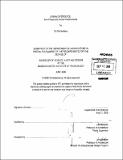| dc.contributor.advisor | Jan Wampler. | en_US |
| dc.contributor.author | Goldenberg, Tal | en_US |
| dc.contributor.other | Massachusetts Institute of Technology. Dept. of Architecture. | en_US |
| dc.date.accessioned | 2011-02-23T14:30:05Z | |
| dc.date.available | 2011-02-23T14:30:05Z | |
| dc.date.copyright | 2009 | en_US |
| dc.date.issued | 2009 | en_US |
| dc.identifier.uri | http://hdl.handle.net/1721.1/61211 | |
| dc.description | Thesis (S.B. in Art and Design)--Massachusetts Institute of Technology, Dept. of Architecture, 2009. | en_US |
| dc.description | Cataloged from PDF version of thesis. | en_US |
| dc.description | Includes bibliographical references (p. 55). | en_US |
| dc.description.abstract | Healthy and sustainable growth of a modern city happens when positive synergy takes place between public transportation and the commercial/residential areas which it serves. In lack of proper synergy, these interfaces ('transit nodes'), lack the human scale, feel sterile and isolated from the city's nature and give rise to awkward, fragmented spaces which are undesired and unoccupied. The MBTA T stops, especially those in the outskirts of Boston, facilitate on a daily basis for hundreds of people who commute into the city and for residents or locals who utilize public transportation. Such stops possess the potential for urban expansion, and can offer a variety of amenities for its comers. Instead, most nodes are left unaccounted for and fail to provide a gradient of program components that create a sense of place and develop an identity which represents its community This thesis offers a prototype for nodes that provide sensible, seamless and healthy transitions between various modes of transportation to its urban vicinity. Nodes contain train stops, bus paths, main roads and public areas. Common constraints due to the nature of the site such as noise, lack of light, and safety issues are integrated into the design scheme to transform the site into a place which bridges among the urban fragments, reconnects public and private and becomes the heart of the local community. | en_US |
| dc.description.statementofresponsibility | by Tal Goldenberg. | en_US |
| dc.format.extent | 55 p. | en_US |
| dc.language.iso | eng | en_US |
| dc.publisher | Massachusetts Institute of Technology | en_US |
| dc.rights | M.I.T. theses are protected by
copyright. They may be viewed from this source for any purpose, but
reproduction or distribution in any format is prohibited without written
permission. See provided URL for inquiries about permission. | en_US |
| dc.rights.uri | http://dspace.mit.edu/handle/1721.1/7582 | en_US |
| dc.subject | Architecture. | en_US |
| dc.title | Urban divergence : from physical to social infrastructures | en_US |
| dc.type | Thesis | en_US |
| dc.description.degree | S.B.in Art and Design | en_US |
| dc.contributor.department | Massachusetts Institute of Technology. Department of Architecture | |
| dc.identifier.oclc | 701317007 | en_US |

